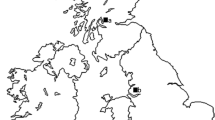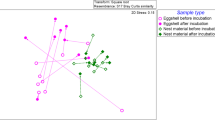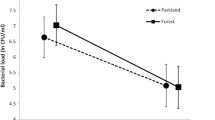Summary
We investigated the bacterial frequency and identified 11 genera of bacteria in starling-nests of a nest box colony in southern Germany. We sampled bacteria with a new method: agar paddles, developed for the food industry, were pressed against the naked belly of nestlings at an age of 14 days for 5 seconds. The bacteria colonies on the paddle surface were counted after incubation and their numbers served as an estimate of bacterial infestation of a nest. Bacteria numbers increased with season and precipitation. No relationship between bacteria load of the nests and hatching and fledging success, nestling mortality and body mass close to fledging was detected. The reason for this may be that a high bacteria load is not necessarily harmful but may even act in a beneficial way on the digestive and immune system. Nevertheless we consider it possible that the higher load of bacteria of late nests may under certain conditions be one of the factors responsible for the frequently observed lower quality of second brood nestlings.
Zusammenfassung
Wir untersuchten Häufigkeit und Gattungszugehörigkeit von Bakterien in Starennestern in einer Nistkastenkolonie in Süddeutschland. Wir fanden Bakterien aus 11 verschiedenen Gattungen. Die Bakterienproben gewannen wir mit einer neuen Methode: Agarpaddeln, die in der Nahrungsmittelindustrie Verwendung finden, wurden 5 Sekunden lang auf den nackten Bauch von 14 Tage alten Nestlingen gepresst. Die sich auf dem Paddel nach 48stündiger Inkubation entwickelnden Bakterienkulturen wurden gezählt und dienten als Maß für den Bakterienbefall eines Nests. Wir fanden einen signifikanten saisonalen Anstieg von Bakterien in den Nestern, der auch mit dem Niederschlag korrelierte. Es gab keine Beziehung zwischen Bakteriendichte und dem Schlüpf- und Ausfliegeerfolg, der Nestlingsmortalität oder dem Gewicht der Nestlinge. Der Grund hierfür könnte sein, dass Bakterien nicht unbedingt schädlich sein müssen, sondern auch einen günstigen Einfluss auf die Verdauung und das Immunsystem der Nestlinge haben können. Wir halten es aber dennoch für möglich, dass unter bestimmten Bedingungen der stärkere bakterielle Befall von späten Nestern mit einer der Gründe für die häufig beobachtete schlechtere Qualität von Jungvögeln aus zweiten Bruten ist.
Similar content being viewed by others
References
Bezzel, E. & Prinzinger, R. (1990): Ornithologie. Stuttgart.
Brock, T. & Madigan, M. (1991): Biology of Microorganisms 6, Prentice Hall.
Clark, L. (1991): Countering parasites and pathogens. Parasitology today 6: 358–360.
Clark, L. & Mason, J. R. (1985): Use of nest material as insecticidal and anti-pathogenic agents by the European starling. Oecologia, 67: 169–176.
Erbelding-Denk, C. & Trillmich, F. (1990): Das Mikroklima im Nistkasten und seine Auswirkungen auf die Nestlinge beim Star (Sturnus vulgaris). J. Ornithol. 131:73–84.
Foster, G., Ross H.M., Pennycott, T.W., Hopkins, G.F., & McLaren, I.M., (1998): Isolation of Escherichia coli 086:K61 producing cytolethal distending toxin from wild birds of the finch family. Letters in Applied Microbiology. 26(69): 395–398.
Gerlach, H. (1993): International meeting of the World Veterinary Poultry Association: 28–38.
Glünder, G. (1980): Occurrence of Enterobacteriaceae in feces of Granivorous Passeriform birds. Avian Diseases 25/1: 195–198.
Gwinner, H. & Berger, S. (2003): Parasite defense in birds. The role of volatiles. Proceed. 23rd Int. Ornithol. Congr., Acta Zoologica Sinica, in press.
Gylstorff, I. & Grimm, F. (1987): Vogelkrankheiten. Stuttgart.
Jones, D. M. and Nisbet, D. J., (1980): The gram negative flora of the avian gut. Avian Pathology 9: 33–38.
Koslowski, St., Malyszko, E., Pinowsk, J., Bernacka, B., Pepinski, W. and Kruszewicz, A., (1989): Pathogenic microorganisms isolated from Passer domesticus and Passer montanus nestlings. Proceed. Int. Symp. on Graniv. Birds INTECOL, Slupsk, Poland.
Literak, I., Cizek, A. & Smola, J. (1995): Occurrence of Salmonellae in the laughing gull (Larus ridibundus). Epidemiologie, Mikrobiologie, Immunologie. 44: 118–20.
Mehmke U., Gerlach, H., Koesters, J., & Hausmann, S., (1993): Studies of the aerobic bacterial flora on the nesting material of singing birds. Dtsch. Tierärztl. Wochenschr. 99: 480–482.
Mills, T.K., Lombardo, M.P. & Thorpe, P. A. (1999): Microbial colonization of the cloacae of nestling Tree Swallows. Auk 116: 947–956.
Pinowski, J., Barkowska, M., Kruszewicz, A. H. & Kruszewicz, A. G. (1994): The causes of the mortality of eggs and nestlings of Passer spp. J. Biosciences (Bangalore) 19:441–451.
Rothschild, M. & Clay, Th. (1957): Fleas, Flukes and Cuckoos. London.
Schlegel, H. G. (1984): Allgemeine Mikrobiologie 6. Göttingen.
Singleton, D. & Harper, R. G. (1998): Bacteria in old housewren nests. J. Field Ornithol. 69: 71–74.
Wimberger, P. H. (1984): The use of green plant material in bird nests to avoid ectoparasites. Auk 101:615–618.
Author information
Authors and Affiliations
Corresponding author
Rights and permissions
About this article
Cite this article
Berger, S., Disko, R. & Gwinner, H. Bacteria in starling nests. J Ornithol 144, 317–322 (2003). https://doi.org/10.1007/BF02465631
Accepted:
Published:
Issue Date:
DOI: https://doi.org/10.1007/BF02465631




